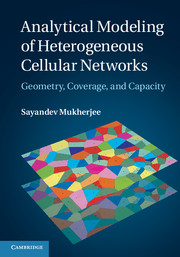Book contents
- Frontmatter
- Contents
- Preface
- Acknowledgemants
- List of notation
- List of acronyms and abbreviations
- 1 Introduction
- 2 Structure of the SINR calculation problem
- 3 Poisson point processes
- 4 SINR analysis for a single tier with fixed power
- 5 SINR analysis for multiple tiers with fixed powers
- 6 SINR analysis with power control
- 7 Spectral and energy efficiency analysis
- 8 Closing thoughts: future heterogeneous networks
- Appendix A Some common probability distributions
- Appendix B HCNs in LTE
- References
- Author index
- Subject index
7 - Spectral and energy efficiency analysis
Published online by Cambridge University Press: 18 December 2013
- Frontmatter
- Contents
- Preface
- Acknowledgemants
- List of notation
- List of acronyms and abbreviations
- 1 Introduction
- 2 Structure of the SINR calculation problem
- 3 Poisson point processes
- 4 SINR analysis for a single tier with fixed power
- 5 SINR analysis for multiple tiers with fixed powers
- 6 SINR analysis with power control
- 7 Spectral and energy efficiency analysis
- 8 Closing thoughts: future heterogeneous networks
- Appendix A Some common probability distributions
- Appendix B HCNs in LTE
- References
- Author index
- Subject index
Summary
Introduction
We have so far studied only the distribution of the SINR at an arbitrarily located user in a single-tier cellular network or a multi-tier HCN. The CCDF of the SINR directly yields a measure of system performance called coverage, as discussed in Section 5.2.4. However, of equal and possibly greater interest to the network designer is another metric variously called throughput, spectral efficiency, and capacity. We favor the use of the term spectral efficiency.
The spectral efficiency can be calculated for each tier, and is defined as the total number of bits of information that an arbitrary BS in that tier can transfer to the set of its served users per use of the wireless “channel” to the users, i.e. per second and per hertz of bandwidth. We shall see that, because the users served by each BS are distributed over some region (the “cell”), this measure of spectral efficiency is an area-averaged quantity, and we shall sometimes refer to it as area-averaged spectral efficiency in order to emphasize this. Further, it is dependent on the details of the scheduling algorithm employed by the BS to select served users for transmission at each transmit interval. However, for the simplest scheduling scheme, where each of the served users is selected in turn for the same number of transmit intervals (called round robin or RR scheduling), we shall show that the area-averaged spectral efficiency is the same as the spectral efficiency on the link to a single randomly selected user served by the BS.
- Type
- Chapter
- Information
- Analytical Modeling of Heterogeneous Cellular NetworksGeometry, Coverage, and Capacity, pp. 141 - 153Publisher: Cambridge University PressPrint publication year: 2014
- 1
- Cited by



